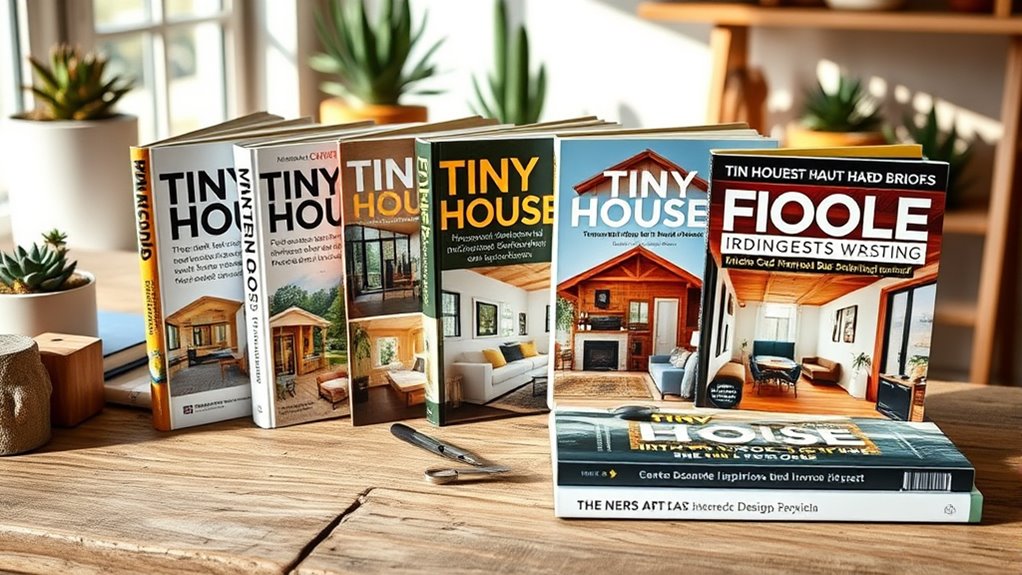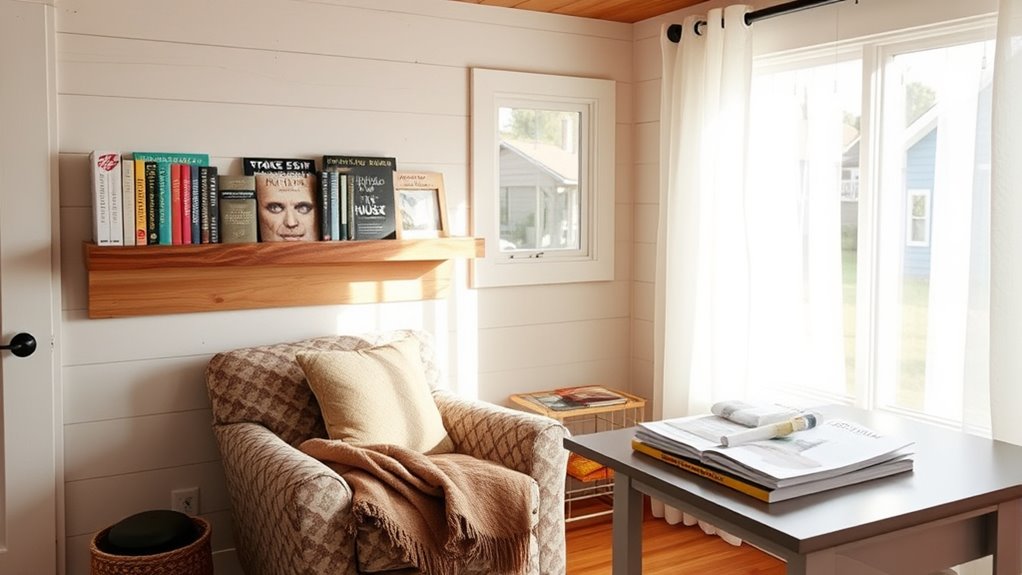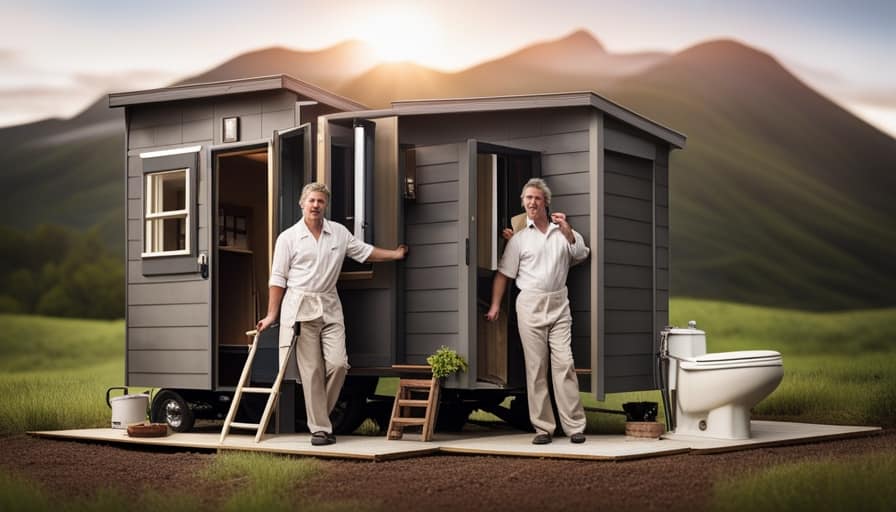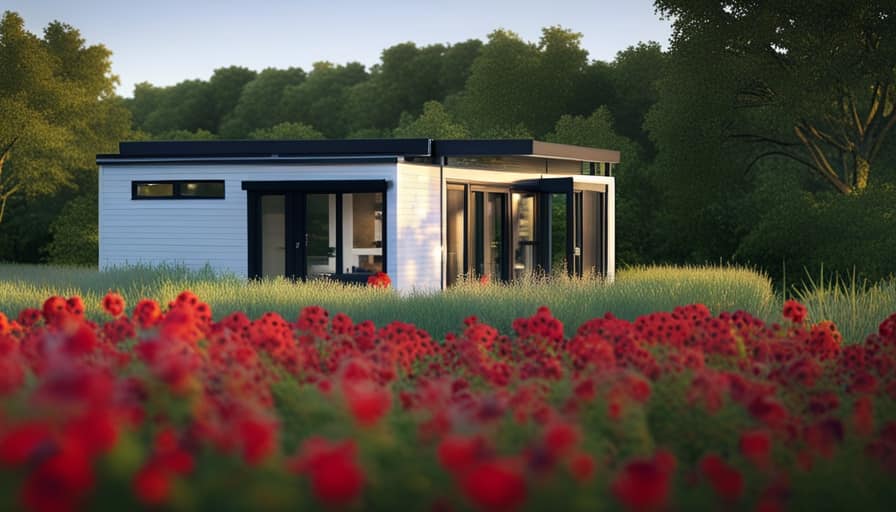If you’re looking for the best books on tiny house design and living, you’ll find guides that share functional space-saving ideas, sustainable materials, and clever layouts. These books often include real-life case studies, blueprints, and tips for creating eco-friendly, efficient homes. They help you turn small spaces into comfortable, stylish homes tailored to your needs. Keep exploring, and you’ll discover expert advice to inspire and guide your tiny house journey.
Key Takeaways
- Look for books that cover space-saving furniture ideas to maximize small living areas effectively.
- Choose titles that emphasize sustainable materials and eco-friendly building practices.
- Seek out resources focusing on layout and design principles tailored for tiny homes.
- Find books featuring real-life case studies and blueprints for practical inspiration.
- Consider guides offering additional tips on interior layout, multifunctional furniture, and efficient living strategies.

If you’re interested in building or designing a tiny house, there are plenty of books that can guide you through the process. These resources often focus on maximizing limited space, emphasizing the importance of space-saving furniture. You’ll discover innovative ideas for multifunctional pieces that serve multiple purposes, like fold-away beds, collapsible tables, and storage-integrated seating. Such furniture helps you make the most of every square inch, ensuring your tiny home feels open and functional rather than cramped. Many books highlight how choosing the right space-saving furniture transforms a small space into a comfortable, efficient living area without sacrificing style or comfort.
Discover space-saving furniture ideas that maximize tiny homes without sacrificing style or comfort.
Alongside furniture, sustainable materials are a key theme in many tiny house design books. These guides show you how to select eco-friendly building materials that reduce your environmental impact and promote healthier living. You’ll learn about reclaimed wood, recycled metal, bamboo, and other sustainable options that not only look great but also contribute to energy efficiency and durability. These books often include practical advice on sourcing sustainable materials, understanding their benefits, and incorporating them into your build for a greener lifestyle. They encourage conscious choices that align with the tiny house ethos of minimalism and sustainability.
Many books also explore the importance of thoughtful layout and design principles. You’ll find tips on how to optimize vertical space, incorporate storage solutions that blend seamlessly into your design, and create open floor plans that feel larger than they are. The focus is on designing spaces that are both functional and aesthetically pleasing, making your tiny house a true reflection of your personality and needs. By exploring these books, you’ll develop a clear understanding of how to combine space-saving furniture with sustainable materials to craft a cozy, eco-friendly home that maximizes every inch.
Furthermore, these books often include real-life case studies and blueprints, giving you concrete examples and inspiration to kickstart your project. They help you visualize how different design elements come together, from clever storage ideas to eco-conscious building choices. Whether you’re a DIY enthusiast or planning to work with professionals, these resources provide valuable insights into creating a tiny house that’s efficient, sustainable, and uniquely yours. They also emphasize the significance of interior layout to enhance functionality and comfort within small spaces. Ultimately, the right books will empower you to make informed decisions, turning your tiny house dreams into a beautifully functional, environmentally responsible home.
Frequently Asked Questions
What Are the Most Affordable Tiny House Building Options?
You can choose affordable construction options like building with reclaimed materials or using simple, DIY-friendly designs. Opt for budget design principles that maximize space without extra costs, such as multifunctional furniture and minimalistic layouts. Consider prefabricated kits or modular tiny homes, which often come at lower prices and reduce labor costs. These approaches help you create a cozy, functional tiny house without breaking the bank, making tiny living accessible and affordable.
How Do I Get Permits for Tiny House Living?
Getting permits for tiny house living might feel like steering a maze, but it’s doable! You’ll need to check local zoning regulations and building codes, which vary widely. Start by contacting your city or county planning office to understand the specific requirements. Submit detailed plans and inspections, and be patient—your tiny dream home is worth the effort! Staying informed guarantees you build legally and avoid any unexpected roadblocks.
What Are Common Space-Saving Furniture Ideas?
You can maximize your tiny space by choosing multi-functional furniture like a sofa bed or a fold-out dining table. Convertible designs, such as wall beds or drop-leaf tables, help you save space during the day and expand when needed. Look for pieces that serve multiple purposes, and consider storage-integrated furniture to keep your tiny home organized and clutter-free. These ideas make your small space both functional and comfortable.
How Do Tiny Houses Impact Property Taxes?
Tiny houses can drastically slash your property tax bills, sometimes by a shocking margin, because they often qualify as accessory dwelling units or small structures that fall under different land classifications. However, you must consider land ownership considerations, as taxes depend heavily on whether you own the land or rent it. Always check local property tax implications before downsizing, ensuring you’re prepared for any changes in land use or ownership rules.
What Are Eco-Friendly Materials for Tiny House Construction?
You can use eco-friendly materials like reclaimed wood, bamboo, cork, and recycled metal for sustainable building in your tiny house. Insulation options like sheep’s wool or cellulose also promote energy efficiency. These choices reduce environmental impact, lower your carbon footprint, and create a healthier living space. By selecting eco-friendly materials, you support sustainable building practices that make your tiny house both eco-conscious and stylish.
Conclusion
Think of these books as maps guiding you through the vast landscape of tiny house living. With each page, you’re uncovering hidden trails, discovering clever shortcuts, and building a path toward a simpler, more intentional life. Just as a compass points true north, let these books steer you toward your dream home and lifestyle. Embrace the journey, knowing that sometimes, the smallest spaces hold the biggest possibilities. Your adventure begins now.







